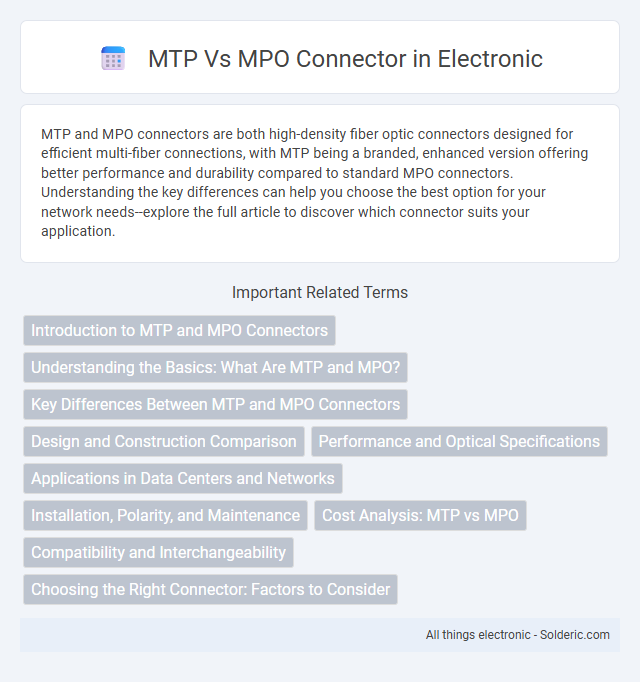MTP and MPO connectors are both high-density fiber optic connectors designed for efficient multi-fiber connections, with MTP being a branded, enhanced version offering better performance and durability compared to standard MPO connectors. Understanding the key differences can help you choose the best option for your network needs--explore the full article to discover which connector suits your application.
Comparison Table
| Feature | MTP Connector | MPO Connector |
|---|---|---|
| Definition | High-performance multi-fiber connector by US Conec | Multi-fiber Push-On connector, generic multi-fiber standard |
| Fiber Count | 12, 24, 48 fibers typically supported | Typically 12 or 24 fibers |
| Insertion Loss | Lower insertion loss (~0.35 dB typical) | Higher insertion loss (~0.75 dB typical) |
| Return Loss | >= 60 dB (Ultra Low Reflectance) | >= 26 dB typical |
| Polarity Maintenance | Improved polarity key and precision alignment | Standard polarity management, less precision |
| Compatibility | Compatible with MPO devices, optimized for performance | Compatible with legacy MPO standards |
| Applications | Data centers, high-speed networks, low loss environments | General use in multi-fiber networks |
| Cost | Higher cost due to advanced specs | Lower cost, widely adopted |
Introduction to MTP and MPO Connectors
MTP and MPO connectors are high-density fiber optic connectors widely used in data centers and telecommunication networks for efficient multi-fiber connectivity. MTP connectors are a brand-name variant of MPO connectors, offering enhanced performance features such as lower insertion loss, higher precision alignment, and reliable polarity management. Both connectors support 12- to 24-fiber configurations, enabling scalable, high-speed network deployments with simplified installation and maintenance.
Understanding the Basics: What Are MTP and MPO?
MTP and MPO connectors are high-density fiber optic connectors used primarily in data centers and telecommunications networks to facilitate efficient multi-fiber cabling. MTP connectors are a premium version of MPO connectors, featuring enhanced mechanical and optical performance through precision engineering and materials. Both connectors support parallel optics applications by aligning multiple fibers in a single interface, significantly increasing data transmission capacity while simplifying cable management.
Key Differences Between MTP and MPO Connectors
MTP connectors are a high-performance variant of MPO connectors, designed with enhanced mechanical and optical specifications for superior signal integrity in fiber optic networks. MPO connectors typically support up to 12 fibers per connector, whereas MTP connectors can handle 12, 24, or 48 fibers, offering greater scalability and density. MTP connectors include features such as precision spring-loaded ferrules and enhanced debris resistance, making them ideal for high-speed data centers and demanding telecommunication environments.
Design and Construction Comparison
MTP connectors feature a precision-engineered pin-and-sleeve design that ensures optimal fiber alignment and low insertion loss, while MPO connectors rely on a simpler mechanical ferrule alignment that can result in slightly higher loss. MTP connectors often incorporate a floating ferrule system that improves connectivity reliability and performance in high-density applications, contrasting with the fixed ferrule design seen in standard MPO connectors. The construction of MTP connectors typically includes enhanced materials and tighter manufacturing tolerances to support rapid installations in demanding data center environments.
Performance and Optical Specifications
MTP connectors offer superior performance over MPO connectors due to enhanced fiber alignment and lower insertion loss, typically achieving insertion loss values as low as 0.35 dB compared to MPO's average of 0.75 dB. Optical specifications for MTP connectors include precise manufacturing tolerances that support high-density, high-bandwidth applications, maintaining return loss better than -55 dB, while MPO connectors usually provide return loss around -40 dB. Your network benefits from MTP technology through improved signal integrity and consistent optical performance essential for data centers and advanced telecommunication systems.
Applications in Data Centers and Networks
MTP connectors support high-density fiber optic cabling in data centers, enabling faster data transmission and simplified network installations. MPO connectors, commonly used in network backbone infrastructure, facilitate multi-fiber connections that optimize space and enhance scalability in large-scale environments. Your choice between MTP and MPO impacts network performance and maintenance efficiency within modern data centers.
Installation, Polarity, and Maintenance
MTP connectors offer easier installation with a push-pull latching system compared to MPO connectors, which require precise alignment of the fiber array to ensure connection integrity. Polarity in MTP connectors is often managed through pre-terminated factory solutions that maintain consistent channel mapping, while MPO connectors may require more manual polarity management during assembly. Maintenance of MTP connectors is simplified due to their durability and standardized components, enabling quicker cleaning and reduced insertion loss, whereas MPO connectors may involve more frequent inspection and adjustment to maintain optimal performance.
Cost Analysis: MTP vs MPO
MTP connectors typically incur higher upfront costs due to superior design, enhanced durability, and multi-fiber management capabilities compared to standard MPO connectors. MPO connectors offer a more economical option for high-density fiber optic applications but may require more frequent replacements or maintenance, impacting long-term expenses. Evaluating total cost of ownership, including installation, maintenance, and lifecycle, is critical for determining the most cost-effective solution between MTP and MPO connectors.
Compatibility and Interchangeability
MTP connectors are a high-performance variation of MPO connectors, designed for enhanced return loss and durability, but both use the same physical ferrule dimensions to ensure compatibility. You can typically interchange MTP and MPO connectors in multi-fiber applications since they adhere to the standardized 12- or 24-fiber MPO footprint, though MTP connectors may offer better performance in high-density environments. Careful attention must be paid to polarity and keying to maintain proper signal alignment and avoid connectivity issues in your network.
Choosing the Right Connector: Factors to Consider
Choosing the right connector between MTP and MPO depends on factors like fiber count, network speed, and ease of installation. MTP connectors offer enhanced performance and reliability for high-density data centers, supporting up to 72 fibers per connector. Your decision should consider compatibility with existing infrastructure and future scalability requirements to optimize network efficiency.
MTP vs MPO connector Infographic

 solderic.com
solderic.com